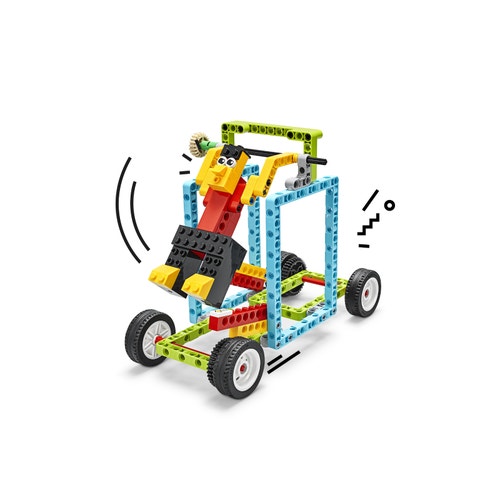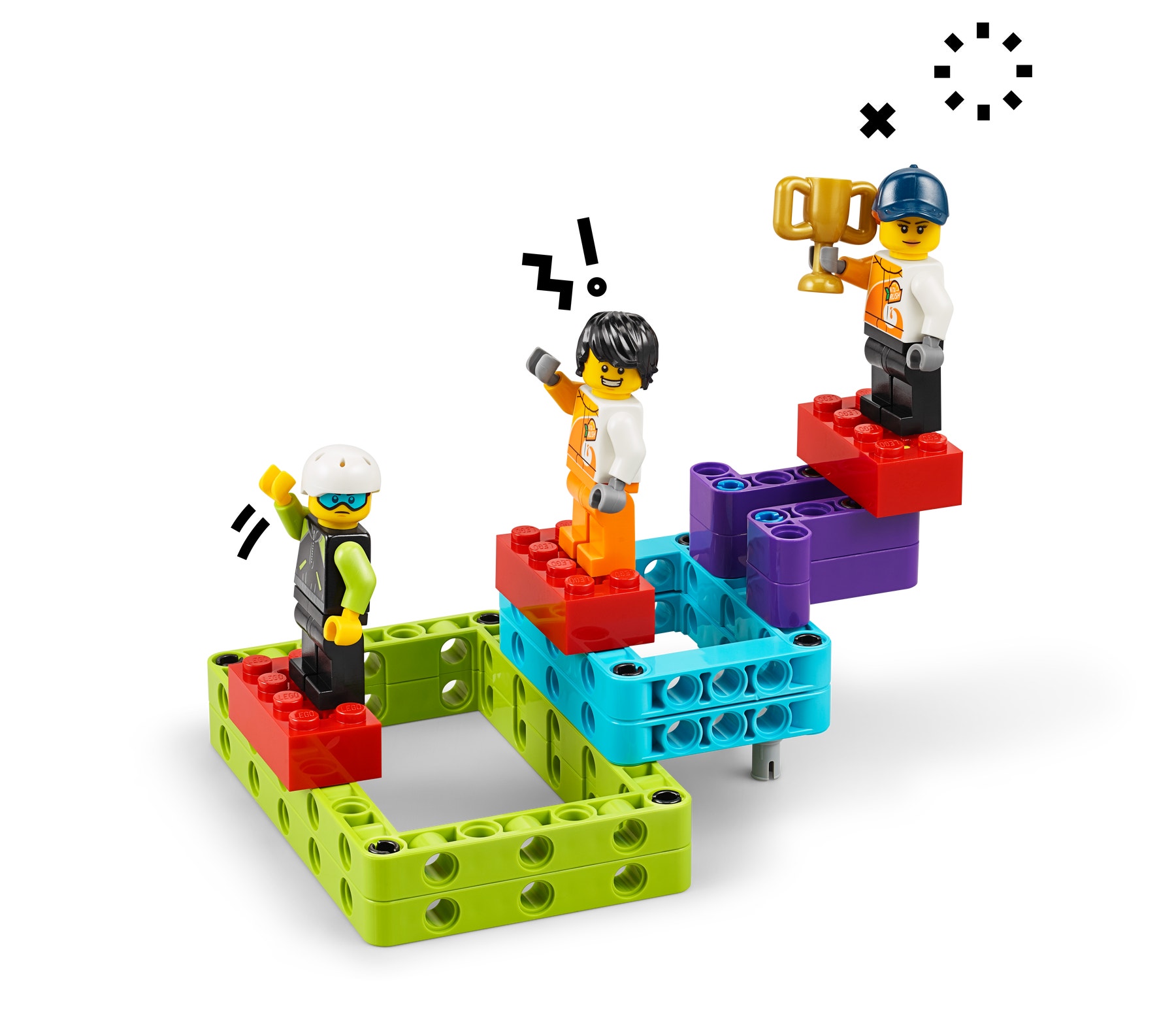Gymnast
What's cooler than a gymnast’s horizontal bar? A horizontal bar on a car! Let's make a gymnast-powered car.

Prepare
- Review the online student material. Use a projector to share this material with your students during the lesson.
- Consider prebuilding the Gymnast model to use during the lesson to help students who are having trouble building.
- Make sure that you've covered the relevant concepts (i.e., Newton’s three laws of motion) in an earlier lesson.
- Consider the abilities and backgrounds of all of your students. Differentiate the lesson to make it accessible to everyone. See the Differentiation section below for suggestions.
Engage
(Whole Class, 5 Minutes)
- Watch the student video here or access it via the online student material.

- Facilitate a quick discussion about the force that helps a gymnast swing on a horizontal bar.
- Ask questions, like:
- Which force is required to make the gymnast move? (Gymnasts use push and pull forces with their muscles to generate forward momentum to overcome the force of gravity that's pulling them down.)
- What keeps the gymnast moving? (Newton’s first law states that an object in motion will stay in motion until it's acted upon by an external force. When their muscles stop pushing, the air resistance and friction between the gymnast’s hands and the bar will eventually bring them to a stop at the bottom of the bar because gravity pulls them down.)
- Tell the students they'll be building a gymnast-powered car.
- Distribute a set to each group.
Explore
(Small Groups, 30 Minutes)
- Have the students work in pairs to build the Gymnast model. Tell them to take turns, one partner searching for the bricks while the other builds, switching roles after each step has been done.
- This model should only take 15 – 20 minutes to build. Once they've finished building, have the students find an open space and give it a try.
- You can find support for building in the Tips section below.
- Next, ask them to perform the 3 experiments found in the student material.
Experiment 1:
- Have the students use a strip of masking tape to mark a line and then swing the gymnast with the ratchet levers folded in and observe what happens.
Experiment 2:
- Next, have them explore how they can make the pendulum car move forward using the ratchet levers.
- Ask the students to flip down the front ratchet lever on their cars.
- Have them place their models on the starting line, pull the pendulum back 90 degrees, and release it.
- Tell them to use a LEGO® brick to mark the distance their car traveled, and to measure and record the distance on their worksheet (Teacher Support – Additional Resources).
- Now have them predict how far their car will travel if they pull the pendulum back as far as it can go (i.e., around 160 degrees). Tell them to place another brick to mark the predicted distance (p).
- Have them test to see if their prediction was correct, and record the actual distance traveled (a) on their worksheet (Teacher Support – Additional Resources).
Experiment 3:
- Have the students fold-in both ratchet levers. Explain that now they'll observe what happens when they release the gymnast with the car resting against their hand.
Explain
(Whole Class, 5 Minutes)
- Gather your students together to share what they've observed in their groups.
- Ask questions, like:
- Why did the car move back and forth with both ratchet levers folded in? (It oscillates backward and forward because the net force is zero.)
- Which forces are at work? (The force of gravity pulls the gymnast down. The momentum of the swing is rigidly attached to the pivot at the top, and there's low friction on the wheels/axles, so the car moves a little bit forward and back as the gymnast swings. The forward motion is more or less equal to the backward motion, so the car doesn’t actually go anywhere.)
-What pattern did you observe in the movement of the car? (The car slows down in between each swing of the gymnast.) - Why does the car's traveling distance decrease between each swing? (The pendulum slowly loses momentum due to friction on the wheels and axles, as well as air resistance, so it'll come to a stop with the pendulum at its lowest point.)
- What effect did a bigger swing of the pendulum have on the distance traveled? (The bigger swing generated more momentum, which made the car go farther.)
- What did you observe when you released the gymnast with the car touching against your hand without the ratchet levers engaged? (There's an equal and opposite force, which you can feel as it presses against your hand when pushing off.)
- If the students are having trouble answering, prompt them by asking:
- Did you push it?
- Then how did it move?
Elaborate
(Whole Class, 5 Minutes)
- If time allows, encourage your students to explore how they can make their car move backward.
- Allow time for the students to disassemble their models, sort the bricks back into the trays, and clean up their workstations.
Evaluate
(Ongoing Throughout the Lesson)
- Give feedback on each student's performance.
- Facilitate self-assessment.
- Use the assessment rubrics provided to simplify the process.
Observation Checklist
- Measure your students’ proficiency in describing how the mass of an object and the forces acting upon it can change its motion.
- Create a scale that matches your needs, for example:
- Needs additional support
- Can work independently
- Can teach others
Self-Assessment
- Have each student choose the brick that they feel best represents their performance:
- Green: With some help, I can describe how force and mass can change an object's motion.
- Blue: I know I can describe how force and mass can change an object's motion.
- Purple: I can describe and explain how force and mass can change an object's motion.
Peer-Feedback
- Encourage your students to assess their peers by:
- Using the brick scale above to score each other's performance
- Presenting their ideas and giving constructive feedback

Tips
Model Tips
- It's common for students to make mistakes while building the gymnast’s arms (i.e., they build them backward). If this happens, show them a completed model and point out the differences in construction.
- Remind your students that counting the holes in the beams and plates will help them place the bricks correctly.
Differentiation
Simplify this lesson by:
- Having the students only do experiments 1 and 3, skipping the ratchets
Increase the difficulty by:
- Having the students figure out for themselves how to make the car move backward, then repeating experiment 2 (They'll have to fold in the front ratchet lever and lower the rear ratchet lever onto the gear.)
- Challenging your students to redesign the model to make it go farther, while still using the same brick weight as the pendulum mass
Extensions
(Note: This will require additional time.)
To incorporate math skills development, ask your students to experiment by pulling the gymnast back at five different angles with one of the ratchet levers engaged. Have them record the distance traveled from each angle. For an added challenge, ask them to plot the height from which the pendulum fell and how far the car moved on an x-y axis. Ask them to explain what the plot looks like and why.
CCSS.MATH.CONTENT.6.SP.B.4
1:1 Hybrid Learning
Download the Personal Learning Kit lesson plan from the hybrid learning resources.
Teacher Support
Students will:
- Explore the motion of a "gymnast" (i.e., pendulum) on wheels and explain how it demonstrates Newton’s three laws of motion
- Predict how the forces acting on an object can change its motion
- LEGO® Education BricQ Motion Prime Set (one for every two students)
- Masking tape
- Yardsticks (one per group)
- NGSS MS-PS2-2
- ISTE: 4c, 6c, 7c
- CCSS.ELA-LITERACY.SL6.1
Lesson extension
- CCSS.MATH.CONTENT.6.SP.B.4